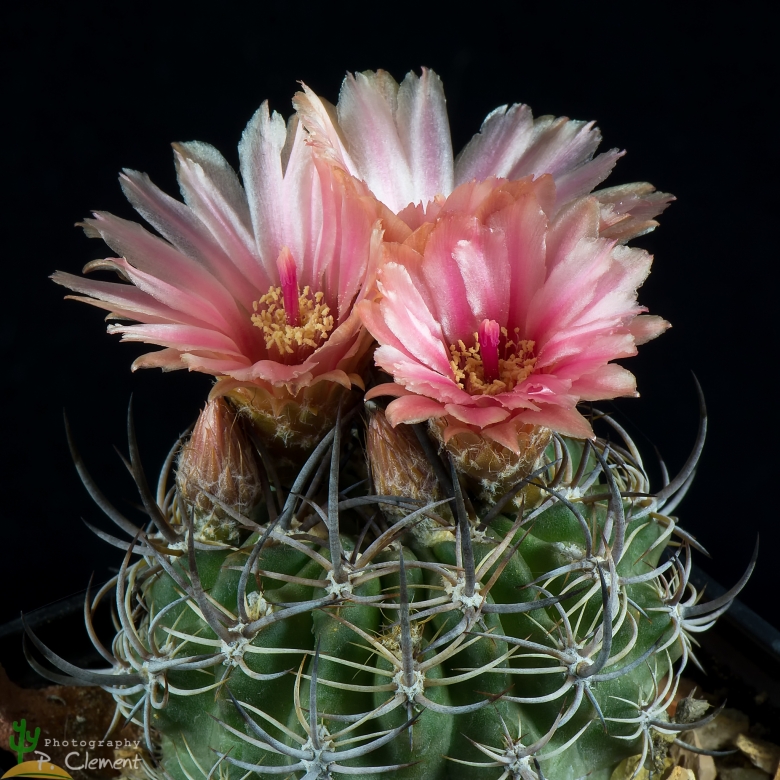Donate now to support the LLIFLE projects.
Your support is critical to our success.
Your support is critical to our success.
= Eriosyce eriosyzoides (F.Ritter) Ferryman
Cactaceae Syst. Init. 16: 11 (11 Oct. 2003)
Accepted Scientific Name: Eriosyce kunzei (C.F.Först.) Katt.
Eriosyce (Cactac.) gen. revis. & ampl. (Succ. Pl. Res., 1) 117 (1994)

Horridocactus eriosyzoides (Eriosyce eriosyzoides) Photo by: Peiffer Clement
Synonyms:
- Eriosyce eriosyzoides (F.Ritter) Ferryman
- Horridocactus eriosyzoides F.Ritter
- Neochilenia eriosyzoides (F.Ritter) Backeb.
- Neoporteria eriosyzoides (F.Ritter) Donald & G.D.Rowley
- Pyrrhocactus eriosyzoides (F.Ritter) F.Ritter
See all synonyms of Eriosyce kunzei
back
Accepted name in llifle Database:Eriosyce kunzei (C.F.Först.) Katt.
Eriosyce (Cactac.) gen. revis. & ampl. (Succ. Pl. Res., 1) 117 (1994)
Synonymy: 30
- Eriosyce kunzei (C.F.Först.) Katt.
- Chilenia kunzei (C.F.Först.) Backeb.
- Echinocactus kunzei C.F.Först.
- Hildmannia kunzei (C.F.Först.) Kreuz. & Buining
- Horridocactus kunzei (Förster) F.Ritter
- Neochilenia kunzei (Förster) Backeb.
- Neochilenia kunzii (C.F.Först.) Backeb. ex Dölz
- Neoporteria kunzei (C.F.Först.) Backeb.
- Neoporteria kunzii (C.F.Först.) Backeb. in Backeb. & F.M.Knuth
- Pyrrhocactus kunzei (C.F.Först.) Borg
- Pyrrhocactus kunzii (C.F.Först.) Borg
- Echinocactus geissei Poselg. ex K.Schum.
- Hildmannia geissei (Poselg. ex K.Schum.) Kreuz. & Buining
- Horridocactus geissei (Poselg. ex K.Schum.) Dölz
- Neoporteria curvispina var. geissei (Poselg. ex K.Schum.) Donald & G.D.Rowley
- Echinocactus kunzei var. brevispinosus C.F.Först.
- Echinocactus kunzei var. rigidior Salm-Dyck
- Echinocactus neumannianus Labour.
- Echinocactus supertextus Pfeiff.
- Eriosyce eriosyzoides (F.Ritter) Ferryman
- Horridocactus eriosyzoides F.Ritter
- Neochilenia eriosyzoides (F.Ritter) Backeb.
- Neoporteria eriosyzoides (F.Ritter) Donald & G.D.Rowley
- Pyrrhocactus eriosyzoides (F.Ritter) F.Ritter
- Neochilenia eriosyzoides var. roseiflora Y.Itô
- Neoporteria densispina Y.Itô
- Neoporteria nidus f. densispina (Y.Itô) Donald & G.D.Rowley
- Neoporteria eriosyzoides var. domeykoensis (F.Ritter) Ferryman
- Neoporteria vallenarensis var. domeykoensis (F.Ritter) A.E.Hoffm.
- Pyrrhocactus eriosyzoides var. domeykoensis F.Ritter
Eriosyce kunzei var. transitensis (F.Ritter) Katt.
Eriosyce (Cactac.) gen. revis. & ampl. (Succ. Pl. Res., 1) 118 (1994)
Synonymy: 7
- Eriosyce kunzei var. transitensis (F.Ritter) Katt.
- Eriosyce eriosyzoides var. transitensis (F.Ritter) A.E.Hoffm. & Helmut Walter
- Neochilenia transitensis (F.Ritter) Backeb.
- Neoporteria curvispina var. transitensis (F.Ritter) Donald & G.D.Rowley
- Neoporteria transitensis (F.Ritter) Ferryman
- Neoporteria vallenarensis var. transitensis (F.Ritter) A.E.Hoffm.
- Pyrrhocactus transitensis F.Ritter
back
| Your Actions | |
|---|---|
| Back to Horridocactus index | |
| Back to Cactaceae index | |
 |
Back to Cacti Encyclopedia index |









